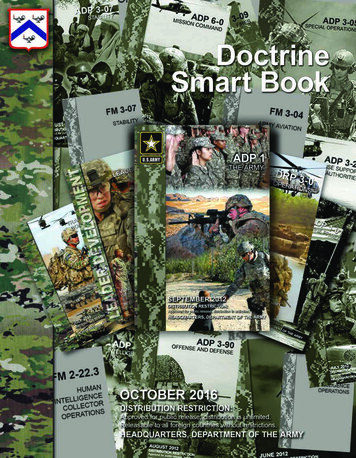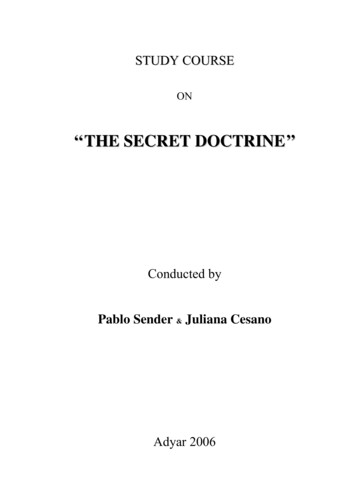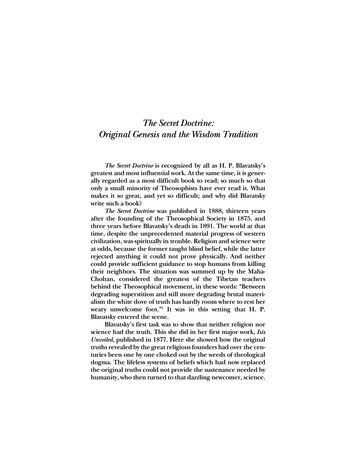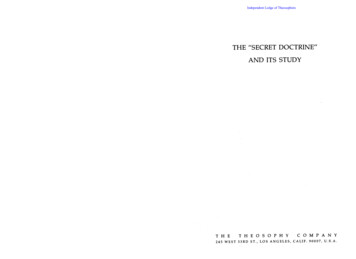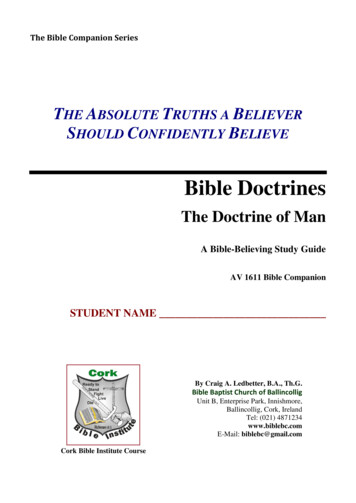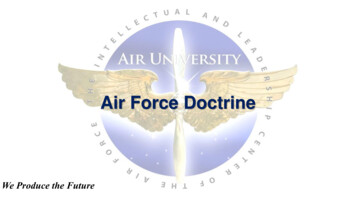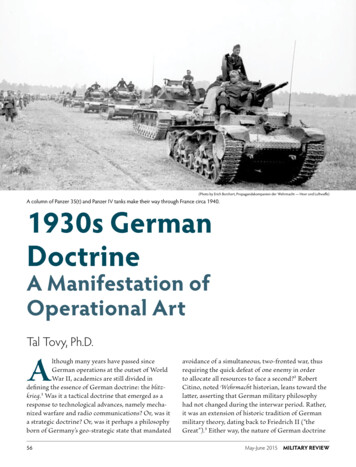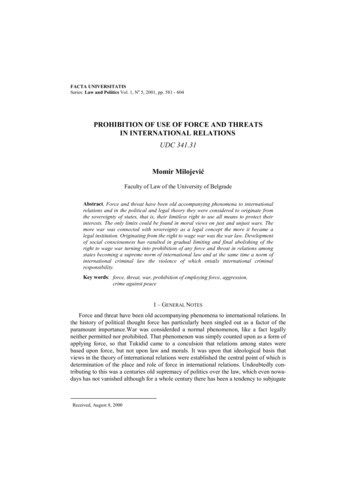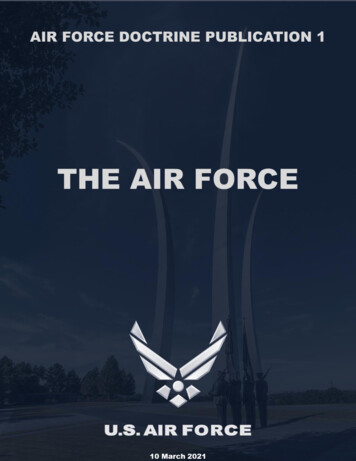
Transcription
CSAF PERSPECTIVE ON DOCTRINEOur Nation needs an Air Force that can fly, fight, and win as part of the joint team.Commanders must articulate intent and prepare to take the initiative in dynamic,contested environments. Doctrine offers an agreed upon, operationally relevant body ofbest practices and principles that articulates how we fight, captures our airpowerexperience, and guides how we operate within a joint force. It provides a starting point,so we don’t reinvent the wheel with every operation and allows us to continue to be theworld’s most capable Air Force.In today's complex global security environment, victory goes to the rapid integrator ofideas. These ideas are driven by training and the distilled knowledge all Airmen bring tothe fight. I’m relying on every Airman to innovate and incorporate concepts andtechnologies that will develop new best practices to shape future doctrine. We mustprioritize and make difficult choices as we field a lethal, resilient, and rapidly adaptingjoint force. Leaders must push decisions to the lowest competent, capable level usingdoctrine as a foundation for sound choices.Doctrine is an opportunity to educate, empower, and prepare for the future fight. Itguides us, but does not bind us. I’m relying on every Airman to understand the lessonsof doctrine, and then draw on them to innovate and incorporate concepts andtechnologies that will develop new best practices to shape future doctrine. This is howwe solve difficult problems, make necessary changes, and how we accelerate change inour Air Force.The tools in doctrine provide an excellent opportunity to build our foundation for futureAirmen and forge unbeatable airpower for our Nation. Airmen should read, understand,contemplate, and prepare for the full spectrum of operations, from competition to armedconflict. Never forget General LeMay’s words: “At the very heart of warfare liesdoctrine.”CHARLES Q. BROWN, JR.General, USAFChief of Staff, United States Air ForceXX MONTH YEAR
PREFACEAir Force doctrine is the extant and emerging best practices in the application ofairpower. Doctrine describes the operations and activities that create convergence ofeffects across the competition continuum. Doctrine is organized as basic, operational,and tactical level doctrine. Basic doctrine states the most fundamental and enduringbeliefs describing airpower and the Airman’s perspective. Operational doctrinedescribes more detailed organization of forces and applies the principles of basicdoctrine to military actions. Tactical doctrine is contained in Air Force and Multi-ServiceTactics, Techniques, and Procedures publications.Blue underlined text denotes a hyperlink to another source document, normally AirForce or joint operational doctrine, for additional discussion.Air Force Doctrine Publication (AFDP) 1, The Air Force, forms the basis of our Serviceculture. It defines airpower, as the ability to project military power through controland exploitation in, from and through the air. Airpower is employed to achieve jointforce commander (JFC) objectives in support of the National Defense Strategy (NDS).AFDP 1 addresses four fundamental topics: Why We Fight - War: our foundational purpose as a Service. Who We Are - Airmen: our values. What We Do - Airpower: airpower fundamentals and perspective. How We Do It - Tenets of Airpower: airpower employment considerations.Ideas presented here enable Airmen to describe what the Air Force provides tojoint all-domain operations (JADO).
Air Force Doctrine Publication 1, The Air ForceTable of ContentsChapter 1 – WHY WE FIGHT: WAR . 1NATURE OF WAR . 1LEVELS OF WARFARE . 1AIRPOWER IN THE COMPETITION CONTINUUM . 2NATIONAL DEFENSE STRATEGY & OBJECTIVES . 2Chapter 2 – WHO WE ARE: AIRMEN . 4Chapter 3 – WHAT WE DO: AIRPOWER . 6DESCRIPTION OF AIRPOWER . 6FOUNDATIONS OF AIRPOWER . 7AIRPOWER FROM AN AIRMAN’S PERSPECTIVE . 8Chapter 4 – HOW WE DO IT: TENETS OF AIRPOWER . 11MISSION COMMAND . 12SYNERGISTIC EFFECTS. 14PERSISTENCE. 15CONCENTRATION. 15PRIORITY . 15BALANCE . 15CONCLUSION. 16
Air Force Doctrine Publication 1, The Air ForceChapter 1 – WHY WE FIGHT: WARIn our victory over Japan, airpower was unquestionablydecisive. That the planned invasion of the JapaneseHome islands was unnecessary is clear evidence thatairpower has evolved into a force in war co-equal withland and sea power, decisive in its own right and worthyof the faith of its prophets.General Carl A. Spaatz, 1st Chief of Staff,United States Air ForceNATURE OF WARWar is one of the means used by nation-states, sub-national groups, or supranationalgroups to achieve their objectives. Conducting war from the air underpins the reason forthe Air Force’s existence. Airpower is an instrument of national power and can beemployed in warfare. There are three basic truths that the Air Force believes arefundamental to warfare: War is an extension of politics by other means. War has been described as aviolent clash of interests characterized by the use of force. The Air Force conductswarfare as an extension of our national policy. War is a complex and chaotic human endeavor. Uncertainty and unpredictability,sometimes called the “fog of war”, combine to create what Clausewitz called“friction” which makes simple operations unexpectedly, and sometimes eveninsurmountably, difficult. The tenets of airpower help Airmen apply airpowereffectively within this environment. War is a clash of opposing wills. War is a collision of two or more forces,producing a dynamic interplay of action and reaction. The will of the people and thecharacter of their leaders are critical components of warfare.Sound doctrine, good leadership, effective organization, moral values, andrealistic training can reduce the effects of uncertainty, unpredictability, andunreliability present in war.LEVELS OF WARFAREAirpower creates effects across all three levels of warfare: strategic, operational, andtactical. The strategic level of war defines why and with what the conflict occurs. Theoperational level of war determines what courses of action, in what order, and for what1
Air Force Doctrine Publication 1, The Air Forceduration forces are employed in the conflict. Finally, the tactical level of war defines howwe create the operational effects. Actions in war occur at the tactical level, but anunderstanding of the operational and strategic implications of those actions is key to theemployment of airpower in pursuit of our national objectives.AIRPOWER IN THE COMPETITION CONTINUUMThe Air Force employs forces in pursuit of our national objectives across thecompetition continuum. Rather than the traditional binary classifications of peace andwar, the competition continuum describes a world of enduring competition conductedthrough a mixture of cooperation, competition below armed conflict, and armed conflict.The Air Force creates effects across the continuum through the conduct of operations,military engagement, security cooperation, deterrence, and other activities.For detailed discussion on the competition continuum, see Joint Doctrine Note 1-19,Competition Continuum, 3 June 2019.NATIONAL DEFENSE STRATEGY & OBJECTIVESThe National Defense Strategy sets the context in which Airmen must anticipate andplan across the competition continuum. Long-term strategic competition and theexpansion of our adversary’s military capabilities threaten the United States’ prosperity2
Air Force Doctrine Publication 1, The Air Forceand security. Joint force operations are increasingly interconnected, interdependent,and challenged. Our adversary’s anti-access and area denial focus and proliferation ofadvanced technologies create contested environments that reduce airpower’s ability toconduct global operations across the competition continuum, reduce freedom ofmaneuver, and challenge the Air Force’s ability to operate. This operating environmentrequires examining how forces will sense, plan, decide, and act in concert across alldomains.The National Defense Strategy delivers the framework that defines the Department ofthe Air Force’s functions. The Air Force, as part of the Department of the Air Force,provides the Nation with global vigilance, global reach, and global power. Servicedoctrine describes how to fulfill that responsibility. Global Vigilance is the ability to gain and maintain awareness anywhere; to providewarning and to determine intent, opportunity, capability, or vulnerability; then to fusethis information with data received from other Services or agencies and use andshare relevant information with the joint force commander (JFC). Global Reach is the ability to project military capability responsively–withunsurpassed velocity and precision–anywhere, and provide mobility to rapidlysupply, position, or reposition joint forces. Global Power is the ability to hold at risk or strike any target anywhere, assertnational sovereignty, safeguard joint freedom of action, and create swift, decisive,precise effects.The Air Force prepares and employs forces within this strategic environment to achieveour national objectives. These objectives include defend the homeland, remain thepreeminent military power in the world, ensure the balances of power remain in ourfavor, and advance an international order that is most conducive to our security andprosperity. When the Air Force mobilizes in the pursuit of these objectives, they areintegrated as a part of the joint force, led by a JFC.The Air Force organizes, trains, and equips forces to be an air component to a JFC. Aspart of the joint force’s air component, our forces must be prepared to accomplish JFCobjectives. The air component commander’s administrative authorities are derived fromTitle 10, U.S. Code and exercised as the commander, Air Force forces (COMAFFOR).The air component commander’s operational authorities are delegated from the JFCand exercised as both the COMAFFOR, over Air Force Forces, and as the functionaljoint force air component commander (JFACC), over joint air forces made available fortasking. Thus, the air component commander leads Air Force forces as theCOMAFFOR and the JFC’s joint air operations as the JFACC. This duality of authoritiesis expressed in the axiom: Airmen work for Airmen and the senior Airman works for theJFC.3
Air Force Doctrine Publication 1, The Air ForceChapter 2 – WHO WE ARE: AIRMENOur Airmen are the competitive edge we have over ouradversaries and the reason we are the world’s greatestAir Force.JoAnne S. Bass, 19th Chief Master Sergeant of the Air ForceAll Airmen support and defend the Constitution of the United States and live byAir Force core values. Historically, the term Airman is associated with uniformedmembers of the US Air Force (officer or enlisted; regular, Reserve, or Guard) regardlessof rank, component, or specialty.1 Today, Air Force civilians and members of the CivilAir Patrol, when conducting missions as the official Air Force Auxiliary, are incorporatedwithin the broader meaning of the term, Airman.Airmen espouse Air Force core values: Integrity first. Service before self. Excellence in all we do.Success hinges on the incorporation of these values into the character of every Airman.Air Force core values are a commitment each Airman makes when joining the Air Force.They provide a foundation for leadership, decision-making, and success, no matter theirrank, the difficulty of the assigned task, or the dangers presented by the mission.Every Airman is a leader and positively influences others to accomplish the mission.Leadership is the art and science of motivating, influencing, and directing Airmen tounderstand and accomplish JFC objectives.2 Two fundamental elements of leadershipare the mission and the Airmen who accomplish it. Effective leadership transformshuman potential into effective performance in the present and prepares capable leadersfor the future. Airmen step forward to lead others in accomplishing the mission whilesimultaneously serving as followers. You can be a commander without being a leader,1This broader meaning does not, however, mean or imply that anyone other than uniformed members ofthe US Air Force are members of the Armed Services in other contexts. For example, in the context ofpunitive Air Force instructions or law of war regulations, care must be taken to ensure the rights andobligations imposed under those regulations are not uniformly applied to both Service members andcivilians.2Air Force Manual 35-15, Air Force Leadership (1948): “Leadership is the art of influencing people toprogress with cooperation and enthusiasm toward the accomplishment of a mission.” Air Force Pamphlet35-49, Air Force Leadership (1985): “Leadership is the art of influencing and directing people toaccomplish the mission.” The definition in the text is a distillation of these earlier efforts.4
Air Force Doctrine Publication 1, The Air Forceor you may be a fine leader without a command, but you must be a good leader to bean effective commander.3I’m firmly convinced that leaders are not born; they’re educated, trained, andmade, as in every other profession. To ensure a strong, ready Air Force, wemust always remain dedicated to this process.General Curtis E. LeMay, 5th Chief of Staff, United States Air ForceAirmen understand the attributes of airpower and should apply airpower with anappreciation for the breadth, scope, and uniqueness it brings to joint all-domainoperations. Airpower is fundamentally distinct from other forms of military power. Itsinherent flexibility allows it to be applied independently or in concert with other forms ofmilitary power. Airmen have a distinct point of view forged from air operationsthroughout history and our unique operating domains.3Concept dates to AFM 35-15 pg 4 (1948).5
Air Force Doctrine Publication 1, The Air ForceChapter 3 – WHAT WE DO: AIRPOWERRegardless of our respective ranks and positions, wemust execute to the best of our abilities and we must doit right the first time because the application of airpoweris serious business where half-hearted efforts andplaying for second place are not options.General Charles Q. Brown, Jr.,22d Chief of Staff, United States Air ForceDESCRIPTION OF AIRPOWERAirpower is defined as the ability to project military power through control andexploitation in, from and through the air. Elevation above the earth’s surfaceprovides relative advantages and creates a mindset that sees competition from a broadperspective. The air domain allows Airmen to exploit airpower’s attributes of speed,range, precision, tempo, lethality, and adaptability to create effects in all domains.These attributes of airpower change the dynamics of competition in ways that enhancethe effectiveness of joint forces through greater mobility and responsiveness. Airmenhave an appreciation for airpower’s broad potential. Airmen do not view or studyairpower as an auxiliary or complementary capability subordinate to another Service.Airmen view their expertise in the application of airpower as the main reason for theService’s existence. The Air Force employs airpower to achieve JFC objectives and tocomplement other components of the joint force.The attributes of airpower create effects throughout the operational environment andcompetition continuum. Airmen apply airpower by bypassing geographical limitations orstriking with precision at critical vulnerabilities within adversary centers of gravity(COGs) at long ranges, on short notice, and for sustained periods. Airpower can controlthe tempo of operations in our favor and leaders employ airpower in concert with allforms of military power. Airmen integrate capabilities across multiple domains to createeffects in support of JFC objectives through joint all-domain operations. While allServices rely heavily on such integration, joint all-domain integration is fundamental tohow Airmen employ airpower as part of the joint force.To enable convergence of effects in all domains, Airmen support JADO by conductingoperations principally in, from, and through: The air domain, defined as “the atmosphere, beginning at the Earth’s surface,extending to the altitude where its effects upon operations become negligible.” The Information Environment (IE), which includes the cyberspace domain. The IE is“the aggregate of individuals, organizations, and systems that collect, process,6
Air Force Doctrine Publication 1, The Air Forcedisseminate, or act on information,” while cyberspace consists of “theinterdependent networks of information technology infrastructures and resident data,including the Internet, telecommunications networks, computer systems, andembedded processors and controllers.” The effective use of information as aninstrument for affecting perceptions and behaviors and to support human andautomated decision-making is an increasingly important element of joint operations. The electromagnetic spectrum (EMS) is defined as “the entire range ofelectromagnetic radiation.” It is critical for connecting the joint force and as amedium for creating effects, freedom of action in the EMS at the time, place, andparameters of the joint force’s choosing, is a required precursor to the successfulconduct of operations in all domains.A comprehensive understanding of operations within the warfighting domains, the EMS,and IE are critical to achieving JFC objectives.The other Services have air arms—magnificent airarms—but their air arms must fit within their Services,each with a fundamentally different focus. So those airarms, when in competition with the primary focus oftheir Services, will often end up on the short end,where the priorities for resources may lead to shortfallsor decisions that are suboptimum. It is thereforeimportant to understand that the core competencies of[airpower] are optional for the other Services. They canelect to play or not play in that arena. But if the nationis to remain capable and competent in air and space[sic], someone must pay attention across the wholespectrum; that is why there is a US Air Force.General Ronald R. Fogleman, 15th Chief of Staff,United States Air ForceFOUNDATIONS OF AIRPOWERThe evolution of airpower stems from the Airman’s original vision of combat from adistance, bypassing the force-on-force clash of surface combat. Originally manifested inlong-range aircraft delivering kinetic weapons, airpower has evolved to include otherglobal capabilities, notably non-kinetic forces and capabilities that can produce lethal ornon-lethal effects. Airpower evolution accelerated as technological advancementsallowed Airmen to conduct a greater percentage of operations globally versusregionally.7
Air Force Doctrine Publication 1, The Air ForceAirpower has successfully influenced strategic political outcomes outside of armedconflict since the Berlin Airlift of 1948. Throughout the Cold War, and continuing undervarious international arms control agreements, Air Force assets have observed andverified compliance, leveraging our national ability to negotiate and influence diplomacy.The Air Force provides JFCs options across the competition continuum, which mayaccomplish objectives without the application of lethal force. Airpower has the ability torespond rapidly to crises anywhere in the world with flexible options that contribute toglobal influence and stability, and communicate US capabilities and resolve toworldwide audiences. Examples include: The deterrent role played by the Air Force’s nuclear-armed bombers andintercontinental ballistic missiles against the existential threat posed by adversaries’strategic forces. The role mobility forces play in humanitarian assistance and disaster responseworldwide. Aviation foreign internal defense by Air Force Special Operations combat aviationadvisors, to build partner capacity and help them protect their societies fromsubversion, insurgency, or extremism.Airmen apply the foundations of airpower across the competition continuum; translatethe benefits of airpower into meaningful objectives and desired effects; and influencethe overall joint planning and execution effort. As experts in the joint application ofairpower, the Airman’s perspective provides the ability to force multiple dilemmas onadversaries, decreasing their decision space for potential courses of action.AIRPOWER FROM AN AIRMAN’S PERSPECTIVEEffective airpower application requires an Airman’s unique perspective. Airmen gainedthis perspective through a century of air operations experience. These distilled truthsshould be at the forefront of an Airman’s perspective when operating with joint partners. Control of the air is a necessary precondition for control of the surface. Thefirst mission of an air force is to defeat or neutralize the enemy airpower so friendlyoperations in all domains can proceed. Airpower creates effects at the strategic level of warfare. Airpower, throughglobal reach and global power, can hold an enemy’s strategic COGs and criticalvulnerabilities at risk immediately and continuously through kinetic or non-kineticmeans. Airpower also has capability for nonlethal strategic influence, as inhumanitarian relief and building partnership activities. Airpower exploits the principles of mass and maneuver simultaneously. Thereare no natural boundaries to prevent air capabilities from quickly concentrating8
Air Force Doctrine Publication 1, The Air Force(physically or in terms of delivered effects) at any point. Airpower can dominate thefourth dimension—time—and compress events to produce physical andpsychological shock. Airpower applies force against many facets of enemy power. Global powerenables airpower to be brought to bear against any lawful target in an enemy systemsimultaneously or separately. It enables rapid expression of our national willwherever and whenever necessary. Airpower is not bound by geographical operating areas and creates effectsthroughout a theater. Airmen view the application of force more from a functionalthan geographic standpoint and classify targets by generated effects rather thanphysical location. Airpower’s attributes combine to make it one of the most versatilecomponents of military power. Its versatility allows it to be rapidly employedagainst strategic, operational, and tactical objectives and in support of multipletheaters simultaneously. The choice of appropriate capabilities is a key aspect in the realization ofairpower. Achieving the full potential of airpower requires timely, actionableintelligence and sufficient command and control (C2) capabilities to permitcommanders to exploit airpower attributes. Airpower is a critical component of operations in the information environment.All Air Force actions, including written or spoken words and displayed or relatedimages, have informational aspects that communicate some message or intent,which can be leveraged to support the achievement of JFC objectives. Shaping andleveraging those messages are integral to operations and planning. Airpower provides more than lethal effects. Global vigilance enables airpower toalleviate crises and provide a visible symbol of international support and powerprojection. Assisting partner nations, building alliances and the perception of credibleairpower, supports deterrence and assurance activities that lead to greater regionalstability and security. Airpower requires protection and sustainment to enable air operations andrequires effective integration of capabilities, people, weapons, bases,logistics, and supporting infrastructure. No single aspect of airpower should betreated in isolation since all elements are essential and interdependent. The AirForce depends on Airmen who command, operate, and sustain forces in anyenvironment including chemical, biological, radiological, and nuclear. The Air Force’scombat support capability and agile combat employment provide the ability to deployglobally, begin operations, and sustain the initiative. Counterair and force protectioncapabilities provide defense for forces. Airpower supports and is supported by9
Air Force Doctrine Publication 1, The Air Forcemilitary power in other domains, from other components, and from other Services. Airpower’s unique attributes necessitate it be centrally controlled by anAirman. Experience has shown the Air Force to be the preferred choice of JFCs toexercise command and control (C2) over the joint air effort. Airmen tend to take abroad view of competition; their focus is on applying airpower to accomplish theJFC’s objectives. Airmen apply airpower through the tenet of mission command.10
Air Force Doctrine Publication 1, The Air ForceChapter 4 – HOW WE DO IT: TENETS OF AIRPOWERStrategic air assault is wasted if it is dissipated piecemeal insporadic attacks between which the enemy has anopportunity to readjust defenses or recuperate.Henry H. Arnold, General of the Air ForceThe application of airpower isrefined by its tenets:Principles of Joint Operations (JP 3-0) Mission Command.Unity of command – purpose is to ensure unity of effort under oneresponsible commander for every objective. Flexibility and versatility.Objective - purpose is to direct every military operation toward aclearly defined, decisive, and achievable goal. Synergistic effects.Offensive – purpose of action is to seize, retain, and exploit theinitiative. Persistence.Mass - purpose is to concentrate the effects of combat power at themost advantageous place and time to produce decisive results. Concentration.Maneuver - purpose is to place the enemy in a position ofdisadvantage through the flexible application of combat power. Priority.Economy of force - purpose is to expend minimum essentialcombat power on secondary efforts to allocate maximum combatpower on primary efforts. Balance.These tenets reflect the uniqueaspects of airpower andcomplement principles of jointoperations. The Air Forcerecognizes unity of effort as the13th principle to highlight itsimportance.4 While the principlesprovide general guidance on theapplication of military force, thetenets provide specificconsiderations for theemployment of airpower.Like principles of jointoperations, airpower tenetsSecurity - purpose is to prevent the enemy from acquiringunexpected advantage.Surprise - purpose is to strike at a time or place or in a manner forwhich the enemy is not prepared.Simplicity - purpose is to increase the probability that plans andoperations will be executed as intended by preparing clear,uncomplicated plans, and concise orders.Restraint - purpose is to prevent the unnecessary use of force.Perseverance - purpose is to ensure the commitment necessary toachieve national objectives.Legitimacy - purpose is to maintain legal and moral authority in theconduct of operations.Unity of Effort (additional Air Force principle) - purpose is toensure that a wide range of agencies operating during acontingency coordinate their resources and focus on the same goal.Joint doctrine recognizes Unity of Effort as a “common operating precept.” See Joint Publication 3-0,Joint Operations.411
Air Force Doctrine Publication 1, The Air Forcerequire informed judgment in application. Airmen tailor the application of tenets tothe operational environment. The competing demands of the principles and tenets (forexample mass versus economy of force, concentration versus balance, and priorityversus objective) require an Airman’s nuanced understanding to strike the requiredbalance. Competition is interactively complex, and no two operations are identical.Airmen apply professional judgment and experience as they employ airpower.MISSION COMMANDThe Airman’s philosophy for the C2 of airpower is mission command. Missioncommand is an approach to C2 that empowers subordinate decision-making forflexibility, initiative, and responsiveness in the accomplishment of commander’s intent.Mission command provides Airmen operating in environments of increasinguncertainty, complexity, and rapid change with the freedom of action needed to exploitemergent opportunities and succeed. Given the global reach and strategic effects ofairpower, the Air Force’s approach to mission command balances the need for tacticalflexibility with the management of global risks. Core principles of mission command are: Build teams through mutual trust. Built over time through shared experiences,mutual trust is shared confidence between commanders, subordinates, and partnersthat they can be relied on and are competent to carry out the mission. Create shared understanding. A common understanding of the environment thatincludes an operation’s purpose, challenges, and ways of solving them equipsdecision-makers at all levels with the insight and foresight needed to make effectivedecisions and manage associated risks. Provide clear commander’s intent. A clear and concise expression of the purposeof
Chapter 1 – WHY WE FIGHT: WAR. NATURE OF WAR . War is one of the means used by nation-states, sub-national groups, or supranational groups to achieve their objectives. Conducting war from the air underpins the reason for the Air Force’s existence. Airpower is an ins

